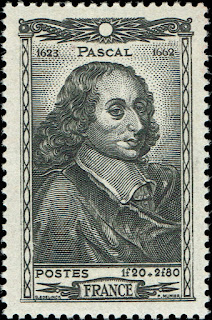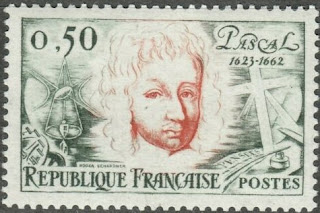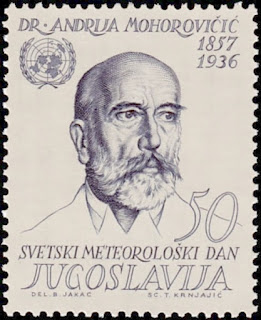Here are some events that happened on January 23rd. It could be an event or a person that died or was born on that day
1656 – Blaise Pascal publishes the first of his Lettres provinciales.
1857 Born: Andrija Mohorovičić, Croatian meteorologist and seismologist (d. 1936)
Andrija Mohorovičić (23 January 1857 – 18 December 1936) was a Croatian meteorologist and seismologist. He is best known for the eponymous Mohorovičić discontinuity and is considered as one of the founders of modern seismology.
On 8 October 1909 there was an earthquake with its epicentre in the Pokuplje region, 39 km southeast of Zagreb. A number of seismographs had been installed beforehand and these provided invaluable data, upon which he made new discoveries. He concluded that when seismic waves strike the boundary between different types of material, they are reflected and refracted, just as light is when striking a prism, and that when earthquakes occur, two waves—longitudinal and transverse—propagate through the soil with different velocities. By analyzing data from more observation posts, Mohorovičić concluded that the Earth has several layers above a core. He was the first to establish, based on the evidence from seismic waves, the discontinuity that separates the Earth's crust from its mantle. This is now called the Mohorovičić discontinuity or (because of the complexity of that name) Moho. According to Mohorovičić, a layered structure would explain the observation of depths where seismic waves change speed and the difference in chemical composition between rocks from the crust and those from the mantle. From the data, he estimated the thickness of the upper layer (crust) to be 54 km. We know today that the crust is 5–9 km below the ocean floor and 25–60 km below the continents, which are carried on tectonic plates. Subsequent study of the Earth's interior confirmed the existence of the discontinuity under all continents and oceans.
Mohorovičić assumed that the velocity of seismic waves increases with the depth. The function he proposed to calculate the velocity of seismic waves is called the Mohorovičić law. He developed a method for determining earthquake epicenters and constructed curves giving the travel times of seismic waves over distances of up to 10,000 miles from the source. He also proposed the construction of a new type of seismograph for recording the ground horizontal movement, but due to lack of funds the project was never realized.
As early as 1909 Mohorovičić started giving lectures that both architects and building contractors should follow, ahead of his time setting some of the basic principles of earthquake-resistant design. Mohorovičić's theories were visionary and were only truly understood many years later from detailed observations of the effects of earthquakes on buildings, deep focus earthquakes, locating earthquake epicenters, Earth models, seismographs, harnessing the energy of the wind, hail defence and other related elements of the geological body of knowledge known as geoscience.
Yugoslavian stamp depicting Mohorovičić
1910 Born: Django Reinhardt, Belgian guitarist and composer (d. 1953)
Jean Reinhardt (23 January 1910 – 16 May 1953), known to all by his Romani nickname Django, was a Belgian-born Romani-French jazz guitarist and composer. He was the first major jazz talent to emerge from Europe and remains the most significant.
With violinist Stéphane Grappelli, Reinhardt formed the Paris-based Quintette du Hot Club de France in 1934. The group was among the first to play jazz that featured the guitar as a lead instrument. Reinhardt recorded in France with many visiting American musicians, including Coleman Hawkins and Benny Carter, and briefly toured the United States with Duke Ellington's orchestra in 1946. He died suddenly of a stroke at the age of 43.
Reinhardt's most popular compositions have become standards within gypsy jazz, including "Minor Swing", "Daphne", "Belleville", "Djangology", "Swing '42", and "Nuages". Jazz guitarist Frank Vignola claims that nearly every major popular-music guitarist in the world has been influenced by Reinhardt. Over the last few decades, annual Django festivals have been held throughout Europe and the U.S., and a biography has been written about his life. In February 2017, the Berlin International Film Festival held the world premiere of the French film Django.
Stamps from Franc and Belgium depicting Django Reinhardt
1944 Died: Edvard Munch, Norwegian painter and illustrator (b. 1863)
Edvard Munch (12 December 1863 – 23 January 1944) was a Norwegian painter. His best known work, The Scream, has become one of the most iconic images of world art.
His childhood was overshadowed by illness, bereavement and the dread of inheriting a mental condition that ran in the family. Studying at the Royal School of Art and Design in Kristiania (today's Oslo), Munch began to live a bohemian life under the influence of nihilist Hans Jæger, who urged him to paint his own emotional and psychological state ('soul painting'). From this emerged his distinctive style.
Travel brought new influences and outlets. In Paris, he learned much from Paul Gauguin, Vincent van Gogh and Henri de Toulouse-Lautrec, especially their use of colour. In Berlin, he met Swedish dramatist August Strindberg, whom he painted, as he embarked on his major canon The Frieze of Life, depicting a series of deeply-felt themes such as love, anxiety, jealousy and betrayal, steeped in atmosphere.
The Scream was conceived in Kristiania. According to Munch, he was out walking at sunset, when he 'heard the enormous, infinite scream of nature'. The painting's agonised face is widely identified with the angst of the modern person. Between 1893 and 1910, he made two painted versions and two in pastels, as well as a number of prints. One of the pastels would eventually command the fourth highest nominal price paid for a painting at auction.
As his fame and wealth grew, his emotional state remained insecure. He briefly considered marriage, but could not commit himself. A breakdown in 1908 forced him to give up heavy drinking, and he was cheered by his increasing acceptance by the people of Kristiania and exposure in the city's museums. His later years were spent working in peace and privacy. Although his works were banned in Nazi Germany, most of them survived World War II, securing him a legacy.
Norwegian stamps depicting Edvard Munch's workd








No comments:
Post a Comment